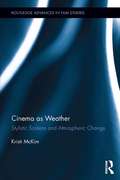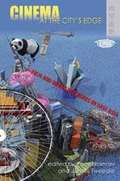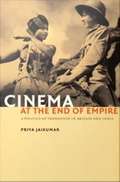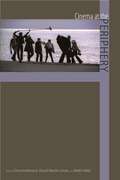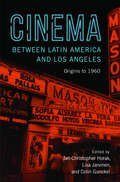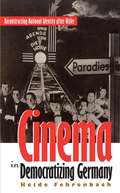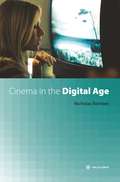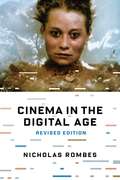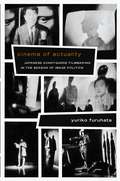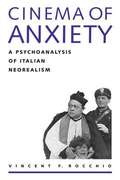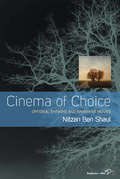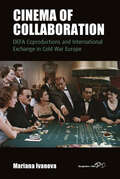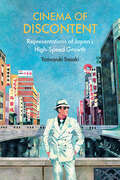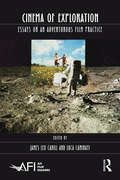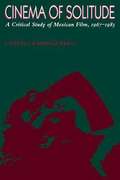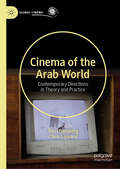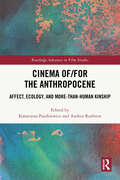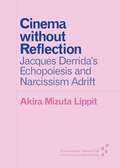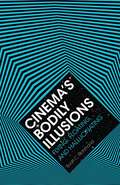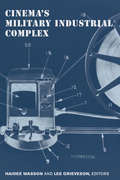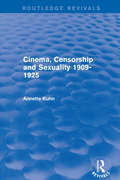- Table View
- List View
Cinema as Weather: Stylistic Screens and Atmospheric Change (Routledge Advances in Film Studies)
by Kristi McKimHow do cinematic portrayals of the weather reflect and affect our experience of the world? While weatherly predictability and surprise can impact our daily experience, the history of cinema attests to the stylistic and narrative significance of snow, rain, wind, sunshine, clouds, and skies. Through analysis of films ranging from The Wizard of Oz to The Umbrellas of Cherbourg, from Citizen Kane to In the Mood for Love, Kristi McKim calls our attention to the ways that we read our atmospheres both within and beyond the movies. Building upon meteorological definitions of weather's dynamism and volatility, this book shows how film weather can reveal character interiority, accelerate plot development, inspire stylistic innovation, comprise a momentary attraction, convey the passage of time, and idealize the world at its greatest meaning-making capacity (unlike our weather, film weather always happens on time, whether for tumultuous, romantic, violent, suspenseful, or melodramatic ends). Akin to cinema's structuring of ephemera, cinematic weather suggests aesthetic control over what is fleeting, contingent, wildly environmental, and beyond human capacity to tame. This first book-length study of such a meteorological and cinematic affinity casts film weather as a means of artfully and mechanically conquering contingency through contingency, of taming weather through a medium itself ephemeral and enduring. Using film theory, history, formalist/phenomenological analysis, and eco-criticism, this book casts cinema as weather, insofar as our skies and screens become readable through our interpretation of changing phenomena.
Cinema at the City's Edge
by Yomi BraesterThis anthology includes a number of leading voices on contemporary Asian cinema studies, including Ackbar Abbas, Chris Berry, Emilie Yueh-yu Yeh, Darrell William Davis, Dudley Andrew, Yomi Braester, Susie Jie Young Kim, Akira Mizuta Lippit, James Tweedie
Cinema at the End of Empire: A Politics of Transition in Britain and India
by Priya JaikumarHow did the imperial logic underlying British and Indian film policy change with the British Empire's loss of moral authority and political cohesion? Were British and Indian films of the 1930s and 1940s responsive to and responsible for such shifts? Cinema at the End of Empire illuminates this intertwined history of British and Indian cinema in the late colonial period. Challenging the rubric of national cinemas that dominates film studies, Priya Jaikumar contends that film aesthetics and film regulations were linked expressions of radical political transformations in a declining British empire and a nascent Indian nation. As she demonstrates, efforts to entice colonial film markets shaped Britain's national film policies, and Indian responses to these initiatives altered the limits of colonial power in India. Imperially themed British films and Indian films envisioning a new civil society emerged during political negotiations that redefined the role of the state in relation to both film industries. In addition to close readings of British and Indian films of the late colonial era, Jaikumar draws on a wealth of historical and archival material, including parliamentary proceedings, state-sponsored investigations into colonial filmmaking, trade journals, and intra- and intergovernmental memos regarding cinema. Her wide-ranging interpretations of British film policies, British initiatives in colonial film markets, and genres such as the Indian mythological film and the British empire melodrama reveal how popular film styles and controversial film regulations in these politically linked territories reconfigured imperial relations. With its innovative examination of the colonial film archive, this richly illustrated book presents a new way to track historical change through cinema.
Cinema at the Periphery: Cinema At The Periphery
by Dina Iordanova David Martin-Jones Belén VidalFrom Iceland to Iran, from Singapore to Scotland, a growing intellectual and cultural wave of production is taking cinema beyond the borders of its place of origin--exploring faraway places, interacting with barely known peoples, and making new localities imaginable. In these films, previously entrenched spatial divisions no longer function as firmly fixed grid coordinates, the hierarchical position of place as "center" is subverted, and new forms of representation become possible. In Cinema at the Periphery, editors Dina Iordanova, David Martin-Jones, and Belén Vidal assemble criticism that explores issues of the periphery, including questions of transnationality, place, space, passage, and migration. Cinema at the Periphery examines the periphery in terms of locations, practices, methods, and themes. It includes geographic case studies of small national cinemas located at the global margins, like New Zealand and Scotland, but also of filmmaking that comes from peripheral cultures, like Palestinian "stateless" cinema, Australian Aboriginal films, and cinema from Quebec. Therefore, the volume is divided into two key areas: industries and markets on the one hand, and identities and histories on the other. Yet as a whole, the contributors illustrate that the concept of "periphery" is not fixed but is always changing according to patterns of industry, ideology, and taste. Cinema at the Periphery highlights the inextricable interrelationship that exists between production modes and circulation channels and the emerging narratives of histories and identities they enable. In the present era of globalization, this timely examination of the periphery will interest teachers and students of film and media studies.
Cinema between Latin America and Los Angeles: Origins to 1960
by Jacqueline Avila Alstair Tremps Viviana García Besné Desirée J. Garcia Nina HoechtlHistorically, Los Angeles and its exhibition market have been central to the international success of Latin American cinema. Not only was Los Angeles a site crucial for exhibition of these films, but it became the most important hub in the western hemisphere for the distribution of Spanish language films made for Latin American audiences. Cinema between Latin America and Los Angeles builds upon this foundational insight to both examine the considerable, ongoing role that Los Angeles played in the history of Spanish-language cinema and to explore the implications of this transnational dynamic for the study and analysis of Latin American cinema before 1960. The volume editors aim to flesh out the gaps between Hollywood and Latin America, American imperialism and Latin American nationalism in order to produce a more nuanced view of transnational cultural relations in the western hemisphere.
Cinema by Design: Art Nouveau, Modernism, and Film History (Film and Culture Series)
by Lucy FischerArt Nouveau thrived from the late 1890s through the First World War. The international design movement reveled in curvilinear forms and both playful and macabre visions and had a deep impact on cinematic art direction, costuming, gender representation, genre, and theme. Though historians have long dismissed Art Nouveau as a decadent cultural mode, its tremendous afterlife in cinema proves otherwise. In Cinema by Design, Lucy Fischer traces Art Nouveau's long history in films from various decades and global locales, appreciating the movement's enduring avant-garde aesthetics and dynamic ideology. Fischer begins with the portrayal of women and nature in the magical "trick films" of the Spanish director Segundo de Chomón; the elite dress and décor design choices in Cecil B. DeMille's The Affairs of Anatol (1921); and the mise-en-scène of fantasy in Raoul Walsh's The Thief of Bagdad (1924). Reading Salome (1923), Fischer shows how the cinema offered an engaging frame for adapting the risqué works of Oscar Wilde and Aubrey Beardsley. Moving to the modern era, Fischer focuses on a series of dramatic films, including Michelangelo Antonioni's The Passenger (1975), that make creative use of the architecture of Antoni Gaudí; and several European works of horror—The Abominable Dr. Phibes (1971), Deep Red (1975), and The Strange Color of Your Body's Tears (2013)—in which Art Nouveau architecture and narrative supply unique resonances in scenes of terror. In later chapters, she examines films like Klimt (2006) that portray the style in relation to the art world and ends by discussing the Art Nouveau revival in 1960s cinema. Fischer's analysis brings into focus the partnership between Art Nouveau's fascination with the illogical and the unconventional and filmmakers' desire to upend viewers' perception of the world. Her work explains why an art movement embedded in modernist sensibilities can flourish in contemporary film through its visions of nature, gender, sexuality, and the exotic.
Cinema in Democratizing Germany
by Heide FehrenbachHeide Fehrenbach analyzes the important role cinema played in the reconstruction of German cultural and political identity between 1945 and 1962. Concentrating on the former West Germany, she explores the complex political uses of film--and the meanings attributed to film representation and spectatorship--during a period of abrupt transition to democracy. According to Fehrenbach, the process of national redefinition made cinema and cinematic control a focus of heated ideological debate. Moving beyond a narrow political examination of Allied-German negotiations, she investigates the broader social nexus of popular moviegoing, public demonstrations, film clubs, and municipal festivals. She also draws on work in gender and film studies to probe the ways filmmakers, students, church leaders, local politicians, and the general public articulated national identity in relation to the challenges posed by military occupation, American commercial culture, and redefined gender roles. Thus highlighting the links between national identity and cultural practice, this book provides a richer picture of what German reconstruction entailed for both women and men.
Cinema in the Digital Age
by Nicholas RombesDoes the digital era spell the death of cinema as we know it? Or is it merely heralding its rebirth? Are we witnessing the emergence of something entirely new? Cinema in the Digital Age examines the fate of cinema in this new era, paying special attention to the technologies that are reshaping film and their cultural impact. Examining Festen (1998), The Blair Witch Project (1999), Timecode (2000), Russian Ark (2002), The Ring (2002), among others, this volume explores how these films are haunted by their analogue past and suggests that their signature element are their deliberate imperfections, whether those take the form of blurry or pixilated images, shakey camera work, or other elements reminding viewers of the human hand guiding the camera. Weaving together a rich variety of sources, Cinema in the Digital Age provides a deeply humanistic look at the meaning of cinematic images in the era of digital perfection.
Cinema in the Digital Age
by Nicholas RombesHave digital technologies transformed cinema into a new art, or do they simply replicate and mimic analogue, film-based cinema? Newly revised and expanded to take the latest developments into account, Cinema in the Digital Age examines the fate of cinema in the wake of the digital revolution. Nicholas Rombes considers Festen (1998), The Blair Witch Project (1999), Timecode (2000), Russian Ark (2002), and The Ring (2002), among others. Haunted by their analogue pasts, these films are interested not in digital purity but rather in imperfection and mistakes—blurry or pixilated images, shaky camera work, and other elements that remind viewers of the human behind the camera.With a new introduction and new material, this updated edition takes a fresh look at the historical and contemporary state of digital cinema. It pays special attention to the ways in which nostalgia for the look and feel of analogue disrupts the aesthetics of the digital image, as well as how recent films such as The Social Network (2010) and The Girl with the Dragon Tattoo (2011)—both shot digitally—have disguised and erased their digital foundations. The book also explores new possibilities for writing about and theorizing film, such as randomization.
Cinema in the Digital Age
by Nicholas RombesDoes the digital era spell the death of cinema as we know it? Or is it merely heralding its rebirth? Are we witnessing the emergence of something entirely new? Cinema in the Digital Age examines the fate of cinema in this new era, paying special attention to the technologies that are reshaping film and their cultural impact. Examining Festen (1998), The Blair Witch Project (1999), Timecode (2000), Russian Ark (2002), The Ring (2002), among others, this volume explores how these films are haunted by their analogue past and suggests that their signature element are their deliberate imperfections, whether those take the form of blurry or pixilated images, shakey camera work, or other elements reminding viewers of the human hand guiding the camera. Weaving together a rich variety of sources, Cinema in the Digital Age provides a deeply humanistic look at the meaning of cinematic images in the era of digital perfection.
Cinema is the Strongest Weapon: Race-Making and Resistance in Fascist Italy
by Lorenzo FabbriA deep dive into Italian cinema under Mussolini&’s regime and the filmmakers who used it as a means of antifascist resistance Looking at Italy&’s national film industry under the rule of Benito Mussolini and in the era that followed, Cinema Is the Strongest Weapon examines how cinema was harnessed as a political tool by both the reigning fascist regime and those who sought to resist it. Covering a range of canonical works alongside many of their neglected contemporaries, this book explores film&’s mutable relationship to the apparatuses of state power and racial capitalism. Exploiting realism&’s aesthetic, experiential, and affective affordances, Mussolini&’s biopolitical project employed cinema to advance an idealized vision of life under fascism and cultivate the basis for a homogenous racial identity. In this book, Lorenzo Fabbri crucially underscores realism&’s susceptibility to manipulation from diametrically opposed political perspectives, highlighting the queer, Communist, Jewish, and feminist filmmakers who subverted Mussolini&’s notion that &“cinema is the regime&’s strongest weapon&” by developing film narratives and film forms that challenged the prevailing ethno-nationalist ideology. Focusing on an understudied era of film history and Italian cultural production, Fabbri issues an important recontextualization of Italy&’s celebrated neorealist movement and the structural ties it shares with its predecessor. Drawing incisive parallels to contemporary debates around race, whiteness, authoritarianism, and politics, he presents an urgent examination into the broader impact of visual media on culture and society. Retail e-book files for this title are screen-reader friendly with images accompanied by short alt text and/or extended descriptions.
Cinema of Actuality: Japanese Avant-Garde Filmmaking in the Season of Image Politics
by Yuriko FuruhataDuring the 1960s and early 1970s, Japanese avant-garde filmmakers intensely explored the shifting role of the image in political activism and media events. Known as the "season of politics," the era was filled with widely covered dramatic events from hijackings and hostage crises to student protests. This season of politics was, Yuriko Furuhata argues, the season of image politics. Well-known directors, including Oshima Nagisa, Matsumoto Toshio, Wakamatsu Kōji, and Adachi Masao, appropriated the sensationalized media coverage of current events, turning news stories into material for timely critique and intermedial experimentation. Cinema of Actuality analyzes Japanese avant-garde filmmakers' struggle to radicalize cinema in light of the intensifying politics of spectacle and a rapidly changing media environment, one that was increasingly dominated by television. Furuhata demonstrates how avant-garde filmmaking intersected with media history, and how sophisticated debates about film theory emerged out of dialogues with photography, television, and other visual arts.
Cinema of Anxiety: A Psychoanalysis of Italian Neorealism
by Rocchio Vincent F.Rocchio builds his analysis around case studies of the films Rome: Open City, Bicycle Thieves, La Terra Trema, Bitter Rice, and Senso. Through the lens of psychoanalysis, he challenges the traditional understanding of Neorealism as a progressive cinema and instead reveals the anxieties it encodes: a society in political turmoil, an economic system in collapse, and a national cinema in ruins; while war, occupation, collaboration, and retaliation remain a part of everyday life.
Cinema of Choice
by Nitzan Ben ShaulStandard Hollywood narrative movies prescribe linear narratives that cue the viewer to expect predictable outcomes and adopt a closed state of mind. There are, however, a small number of movies that, through the presentation of alternate narrative paths, open the mind to thoughts of choice and possibility. Through the study of several key movies for which this concept is central, such as Sliding Doors, Run Lola Run, Inglourious Basterds, and Rashomon, Nitzan Ben Shaul examines the causes and implications of optional thinking and how these movies allow for more open and creative possibilities. This book examines the methods by which standard narrative movies close down thinking processes and deliver easy pleasures to the viewer whilst demonstrating that this is not the only possibility and that optional thinking can be both stimulating and rewarding.
Cinema of Collaboration: DEFA Coproductions and International Exchange in Cold War Europe (Film Europa #21)
by Mariana IvanovaFrom their very inception, European cinemas undertook collaborative ventures in an attempt to cultivate a transnational “Film-Europe.” In the postwar era, it was DEFA, the state cinema of East Germany, that emerged as a key site for cooperative practices. Despite the significant challenges that the Cold War created for collaboration, DEFA sought international prestige through various initiatives. These ranged from film exchange in occupied Germany to partnerships with Western producers, and from coproductions with Eastern European studios to strategies for film co-authorship. Uniquely positioned between East and West, DEFA proved a crucial mediator among European cinemas during a period of profound political division.
Cinema of Discontent: Representations of Japan's High-Speed Growth (SUNY series, Horizons of Cinema)
by Tomoyuki SasakiFrom the mid-1950s to the mid-1970s, Japan experienced an unprecedented level of economic growth, transforming itself from a war-devastated country to a global economic power. Our image of postwar Japan has been shaped by this event, and we tend to see its history as a story of great national success. Cinema of Discontent challenges this view and details the tensions generated by massive and intense capitalist development through analyses of popular cinema produced during the era of high-speed growth. The films discussed in this book, directed by Kawashima Yūzō, Masumura Yasuzō, Inoue Akira, Ezaki Mio, and Kumashiro Tatsumi, attracted broad audiences yet remain understudied. Cinema of Discontent contextualizes these films in relation to the politics, economy, intellectual discourse, and cultural texts of the time. By doing so, it demonstrates how these films address problems immanent to Japan's postwar capitalism, including uneven development, increasing corporate control over individuals, precarious and contingent work, and militarized peace and prosperity.
Cinema of Exploration: Essays on an Adventurous Film Practice (AFI Film Readers)
by James Leo Cah Luca CaminatiDrawing together 18 contributions from leading international scholars, this book conceptualizes the history and theory of cinema’s century-long relationship to modes of exploration in its many forms, from colonialist expeditions to decolonial radical cinemas to the perceptual voyage of the senses made possible by the cinematic apparatus. This is the first anthology dedicated to analysing cinema’s relationship to exploration from a global, decolonial, and ecological perspective. Featuring leading scholars working with pathbreaking interdisciplinary methodologies (drawing on insights from science and technology studies, postcolonial theory, indigenous ways of knowing, and film theory and history), it theorizes not only cinema’s implication in imperial conquest but also its cutting-edge role in empirical expansion and experiments in sensual and critical perception. The collected essays consider filmmaking in cross-cultural contexts and films made in or about peoples in South America, Asia, Africa, Indigenous North America, as well as polar, outer space, and underwater exploration, with famous figures such as Jacques Yves Cousteau alongside amateur and scientific filmmakers. The essays in this collection are ideal for a broad range of scholars, graduate students, and advanced undergraduate students in cinema and media studies, cultural studies, and cognate fields.
Cinema of Solitude: A Critical Study of Mexican Film, 1967-1983
by Berg Charles RamírezIn thematically arranged chapters, Berg investigates the images of women, men, and social structures portrayed in New Cinema films. He finds that women characters have begun to reject traditional stereotypes for more positive images, while male characters have grown ambiguous and undefined as machismo is abandoned. Other chapters trace the continuing marginalization of Indians in Mexican culture, the changes in male dominance within the family, and the disruptive social and economic effects caused by migration.
Cinema of the Arab World: Contemporary Directions in Theory and Practice (Global Cinema)
by Terri Ginsberg Chris LippardThis volume engages new films and modes of scholarly research in Arab cinema, and older, often neglected films and critical topics, while theorizing their structural relationship to contemporary developments in the Arab world. The volume considers the relationship of Arab cinema to transnational film production, distribution, and exhibition, in turn recontextualizing the works of acknowledged as well as new directorial figures, and country-specific phenomena. New documentary and experimental practices are referenced and critiqued, while commercial cinema is covered both as an industrial product and as one of several instances of contestation. The volume thus showcases the breadth and depth of Arab film culture and its multilayered connections to local conditions, regional affiliations, and the tendencies and aesthetics of global cinema.
Cinema of/for the Anthropocene: Affect, Ecology, and More-Than-Human Kinship (Routledge Advances in Film Studies)
by Andrea Ruthven Katarzyna PaszkiewiczCinema of/for the Anthropocene sheds new light on the question of how films can allow us to resituate ourselves within what is known today as the Anthropocene. The authors address this question through a variety of disciplines and theoretical perspectives, from film and cultural studies, new materialisms, critical posthumanism and animal studies, critical race theory and Indigenous media studies, to gender and sexuality studies, with a primary focus on films produced in the United States and Canada.The volume moves beyond the mere acknowledgment of the devastating damage inflicted during the Anthropocene to think about new ways of inhabiting the world through concepts such as affect, response-ability, and more-than-human kinship. The writers in this collection respond to its invitation by addressing a range of genres and modes, thus complicating the apocalyptic discourses which have typically been central to the studies on the Anthropocene: in addition to dystopian films, the volume discusses animated films, Hollywood biopics, climate change documentaries, experimental film, comedy, horror sci-fi, as well as disease thriller and survival film. Taken together, the chapters offer cross-disciplinary readings of the cinema of/for the Anthropocene, showing ways in which it can help us re-orient our thinking to make sense of the current age and address the planetary-scale environmental catastrophe.This volume will appeal to researchers and students in film studies, cultural studies, and the burgeoning field of environmental humanities.
Cinema under National Reconstruction: State Censorship and South Korea’s Cold War Film Culture
by Hye Seung ChungCinema under National Reconstruction calls for a revisionist understanding of state film censorship during successive Cold War military regimes in South Korea (1961–1988). Drawing upon primary documents from the Korean Film Archive’s digitized database and framing South Korean film censorship from a transnational perspective, Hye Seung Chung makes the case that, while political oppression/repression existed inside and outside the film industry during this period, film censorship was not simply a tool for authoritarian dictatorship. Through such case studies as Yu Hyun-mok’s The Stray Bullet (1961), Ha Kil-jong’s The March of the Fools (1975), and Yi Chang-ho’s Declaration of Fools (1983), the author defines censorship as a dialogical process of cultural negotiations wherein the state, the film industry, and the public fight out a battle over the definitions and functions of national cinema. In the context of Cold War Korea, one cannot fully understand or construct film history without reassessing censorship as a productive feedback system where both state regulators and filmmakers played active roles in shaping the new narrative or sentiment of the nation on the big screen.
Cinema without Reflection: Jacques Derrida’s Echopoiesis and Narcissim Adrift (Forerunners: Ideas First)
by Akira Mizuta LippitCinema without Reflection traces an implicit film theory in Jacques Derrida&’s oeuvre, especially in his frequent invocation of the myth of Echo and Narcissus. Derrida&’s reflections on the economies of image and sound that reverberate in this story, along with the spectral dialectics of love, mirrors, and poiesis, serve as the basis for a theory of cinema that Derrida perhaps secretly imagined. Following Derrida&’s interventions on Echo and Narcissus across his thought on the visual arts, Akira Mizuta Lippit seeks to return to a theory of cinema adrift in Derrida&’s philosophy. Forerunners is a thought-in-process series of breakthrough digital works. Written between fresh ideas and finished books, Forerunners draws on scholarly work initiated in notable blogs, social media, conference plenaries, journal articles, and the synergy of academic exchange. This is gray literature publishing: where intense thinking, change, and speculation take place in scholarship.
Cinema's Bodily Illusions: Flying, Floating, and Hallucinating
by Scott C. RichmondDo contemporary big-budget blockbuster films like Gravity move something in us that is fundamentally the same as what avant-garde and experimental films have done for more than a century? In a powerful challenge to mainstream film theory, Cinema&’s Bodily Illusions demonstrates that this is the case. Scott C. Richmond bridges genres and periods by focusing, most palpably, on cinema&’s power to evoke illusions: feeling like you&’re flying through space, experiencing 3D without glasses, or even hallucinating. He argues that cinema is, first and foremost, a technology to modulate perception. He presents a theory of cinema as a proprioceptive technology: cinema becomes art by modulating viewers&’ embodied sense of space. It works primarily not at the level of the intellect but at the level of the body. Richmond develops his theory through examples of direct perceptual illusion in cinema: hallucinatory flicker phenomena in Tony Conrad&’s The Flicker, eerie depth effects in Marcel Duchamp&’s Anémic Cinéma, the illusion of bodily movement through onscreen space in Stanley Kubrick&’s 2001, Godfrey Reggio&’s Koyaanisqatsi, and Alfonso Cuarón&’s Gravity. In doing so he combines insights from Maurice Merleau-Ponty&’s phenomenology of perception and James J. Gibson&’s ecological approach to perception. The result is his distinctive ecological phenomenology, which allows us to refocus on the cinema&’s perceptual, rather than representational, power.Arguing against modernist habits of mind in film theory and aesthetics, and the attendant proclamations of cinema&’s death or irrelevance, Richmond demonstrates that cinema&’s proprioceptive aesthetics make it an urgent site of contemporary inquiry.
Cinema's Military Industrial Complex
by Haidee Wasson Lee GrievesonThe vast and influential American military has been aided and abetted by cinema since the earliest days of the medium. The army, navy, and air force put films to work in myriad ways, enlisting them to entertain, train, and heal soldiers as well as to propagandize, strategize, spy, map, and develop weapons, from rifles to atomic bombs. Presenting new essays based on archival research, Cinema’s Military Industrial Complex addresses the relationship of military cinema to Hollywood, technological innovation, new modes of filmmaking, unique film styles and genres, and the rise of American soft power across the long twentieth century. This rich and timely volume is essential for scholars interested in the military’s use of media and the exercise of influence within and beyond American borders.
Cinema, Censorship and Sexuality 1909-1925 (Cinema And Society Ser.)
by Annette KuhnFirst published in 1988. This book shows how censorship as a set of institutions, practices and discourses was involved in the struggle over the nature of cinema in the early twentieth century. It also reveals the part played in this struggle by other institutions, practices and discourses — for example ‘new’ knowledge about sexuality and organisations devoted to the promotion of public morality. Instead of censorship simply being an act of prohibition by a special institution, this work reveals the issues at work were far more complex and contradictory — opening up critical scrutiny and challenging assumptions. This title will be of interest to students of media and film studies.
